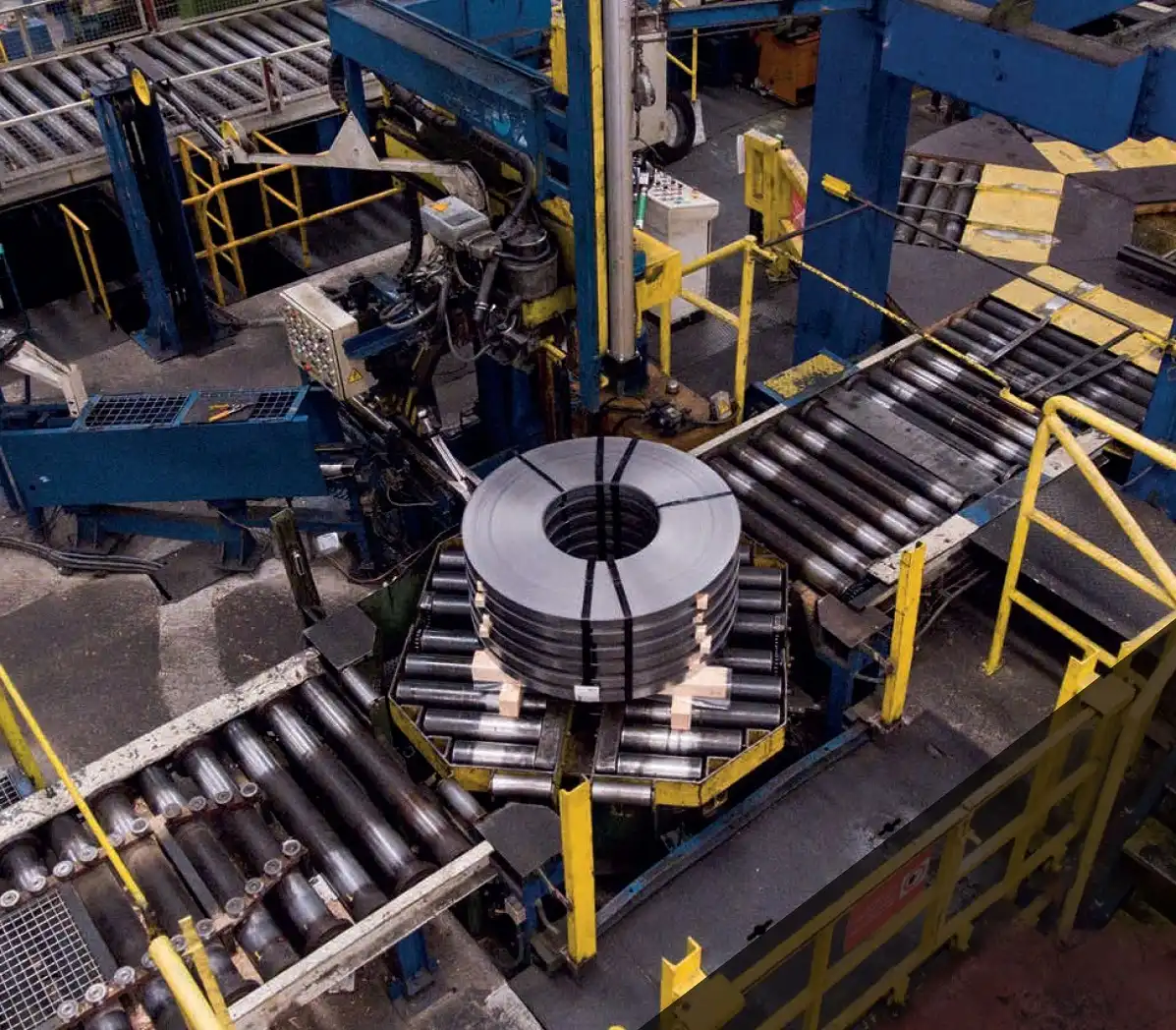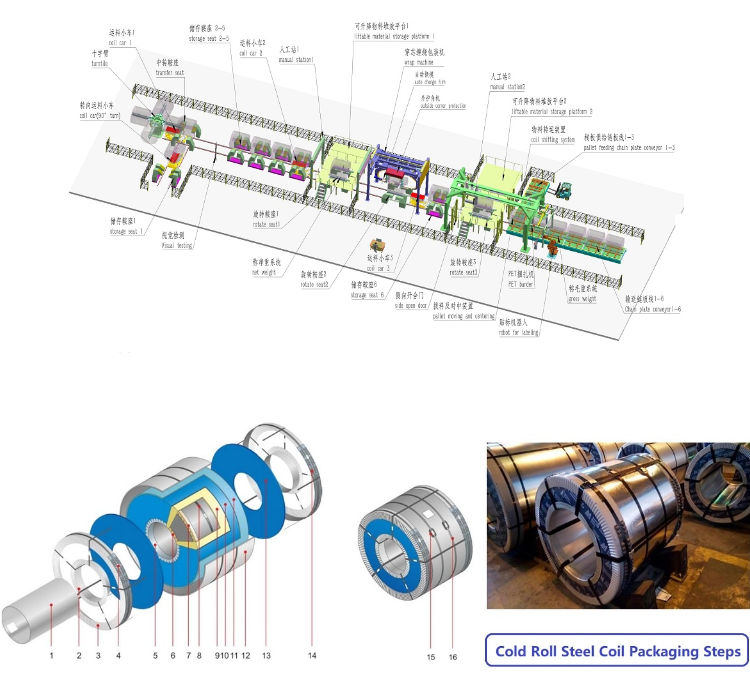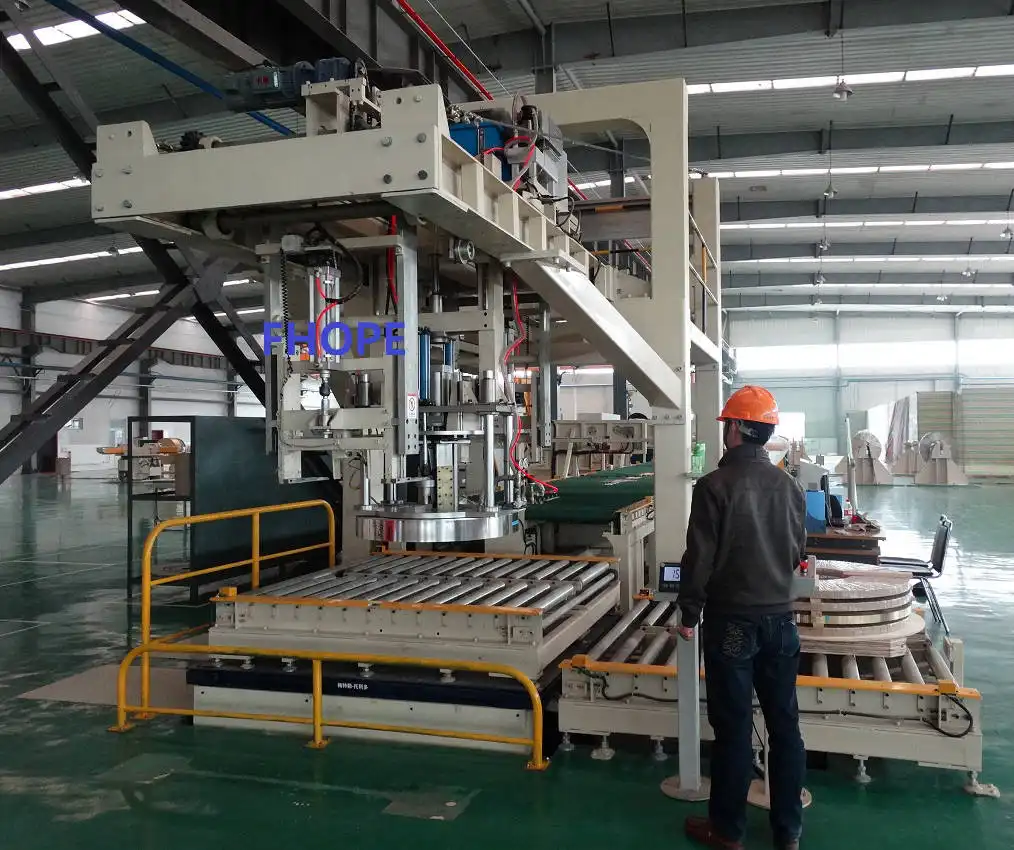In a market as tough as Argentina's, steel mill owners face immense pressure. Fluctuating energy prices, aging equipment, and strict environmental regulations squeeze profit margins. Your packaging line, often seen as the last step, can become a major bottleneck. It can cause delays and drive up costs. Every minute a coil waits to be packaged is a minute you're losing money. An inefficient packaging line means higher labor costs, potential damage to your valuable products, and missed delivery deadlines. It feels like you're running a race with weights tied to your ankles. But what if you could turn that final step into your competitive advantage? By strategically improving your coil packaging efficiency, you can cut costs, boost throughput, and ensure your products reach customers safely and on time. It's not just about buying a new machine. It's about building a smarter, more resilient packaging process.
To improve coil packaging efficiency in Argentina's competitive market, steel producers should focus on three key areas. First, automate manual processes with reliable machinery. Second, integrate smart technologies like IoT for predictive maintenance. Third, partner with an expert who can provide a total solution from design to long-term support. This approach directly tackles bottlenecks, reduces operational costs, and increases overall throughput.

I've been in this industry for a long time. I started as an engineer on the factory floor. Now I am the founder of SHJLPACK. I've seen firsthand how a well-designed packaging line can transform a business. It's about more than just wrapping steel. It's about securing your revenue. Let's break down exactly how you can achieve this. We'll look at the practical steps and real-world benefits.
How can automating coil packaging lines tackle rising labor costs and aging equipment?
Your most experienced workers might be nearing retirement. Finding skilled replacements is difficult and expensive. Meanwhile, your old packaging equipment probably breaks down more often. This causes unexpected downtime and costly emergency repairs. You are fighting a battle on two fronts: rising labor costs and unreliable machinery. Each breakdown means your entire production line grinds to a halt. You pay your team to stand around while a technician tries to fix a 15-year-old machine. The pressure mounts, deadlines are missed, and the costs just keep adding up. It feels like a constant state of crisis management. Automation offers a direct and powerful solution. A modern, automated coil packaging line can run 24/7 with minimal supervision. It handles the heavy, repetitive tasks reliably. This frees up your skilled workers for more valuable roles like quality control and maintenance planning. This shift turns a major liability into a streamlined, cost-effective operation.
Automating a coil packaging line directly addresses rising labor costs and aging equipment by replacing manual, error-prone tasks with consistent, high-speed machinery. This reduces the need for extensive manual labor and minimizes human error. It also replaces unreliable old machines with new, efficient systems that offer higher uptime and predictive maintenance capabilities. This significantly lowers operational costs and boosts productivity.

When I talk about automation, I'm not just talking about a single wrapping machine. I'm talking about an integrated system. I remember a client, much like you, who was struggling with a packaging bottleneck. His team was manually strapping and wrapping massive steel coils. It was slow, physically demanding, and frankly, dangerous. The aging strapping tool was a constant source of frustration. We didn't just sell him a new machine. We analyzed his entire workflow. We looked at how coils came off the slitter, how they were moved, and how they were prepared for shipping. The solution was a fully automatic line.
From Manual Labor to System Integration
The first step is to map out your current process. You must identify every manual touchpoint.
- Coil transport from production
- Coil upending or tilting
- Strapping (radial and circumferential)
- Wrapping
- Weighing and labeling
- Stacking and storage
An automated system integrates these steps. For example, a turnstile receives the coil. Then a coil car moves it to the strapping station. Robotic arms apply the straps. Finally, an orbital wrapper applies the protective film. This is all done without a single person touching the coil.
Comparing Old vs. New
Let's put this into a table to see the real difference. This is the kind of analysis I do with all my clients. It helps justify the investment.
| Feature | Old Manual/Semi-Auto Line | Modern Automated Line |
|---|---|---|
| Throughput | 5-10 coils/hour | 20-30 coils/hour |
| Labor Required | 3-4 operators per shift | 1 supervisor per shift |
| Equipment Uptime | ~80% (frequent breakdowns) | >95% (with predictive maintenance) |
| Material Waste | High (inconsistent film/strap use) | Minimal (precise, controlled application) |
| Safety Incidents | Higher risk of strains, cuts | Virtually eliminated |
| Data Collection | Manual logs, often inaccurate | Automatic (weight, dimensions, time) |
The impact is huge. You're not just replacing old equipment. You are fundamentally changing your operational model. You reduce direct labor costs, yes. But you also reduce material waste, improve safety, and get reliable data. You can use this data to make better business decisions. This is how you tackle aging equipment and rising costs head-on.
What's the real ROI of upgrading to a smart coil packaging system?
As a CEO, you need to justify every major investment. A new smart packaging line looks great on paper, but the upfront cost can be intimidating. You're asking, "When will I see my money back? Is this a necessary expense or a luxury?" The fear of making the wrong investment is real. You've heard stories of factories buying expensive technology that failed to deliver on its promises. It becomes a monument to wasted capital. You can't afford a misstep, especially in Argentina's volatile market. A proper Return on Investment (ROI) analysis removes the guesswork. It's not just about cost savings. A smart system generates value in multiple ways. These include increased throughput, reduced waste, lower maintenance costs, and improved product quality. I help my clients build a clear, data-backed business case. It shows not just if but how quickly the investment will pay for itself and start generating profit.
The real ROI of upgrading to a smart coil packaging system comes from a combination of direct cost savings and indirect value gains. Direct savings include reduced labor, lower material consumption, and decreased maintenance costs. Indirect gains, which are often larger, include increased production capacity, higher product quality with less damage, enhanced worker safety, and the ability to make data-driven decisions that optimize the entire production chain.

Calculating the ROI for a smart packaging line goes far beyond a simple "cost of machine vs. labor saved" equation. As an engineer who now runs a business, I live by the numbers. Let's break down the components of a true ROI calculation, the way a CEO would need to see it.
Quantifying the Tangible Savings
These are the easy-to-measure benefits. We can put a real value on them.
- Labor Cost Reduction: This is the most obvious one. If you go from 3 operators to 1 supervisor per shift, running 3 shifts, the savings are substantial. You can calculate it like this:
(Old Labor Cost - New Labor Cost) x Shifts x Days of Operation. - Material Cost Reduction: Smart wrappers use stretch film more efficiently. They have pre-stretch carriages that can get 300% or more stretch. This means one meter of film becomes four meters. The formula is simple:
(Old Film Consumption - New Film Consumption) x Cost per Roll. - Maintenance Cost Reduction: Old machines require constant reactive maintenance. New systems with IoT sensors enable predictive maintenance. You replace parts before they fail. This can be calculated as
(Old Annual Maintenance Budget - New Annual Maintenance Budget). - Reduced Product Damage: Think about how many coils are damaged during handling and shipping each year. Even a 1% reduction can mean thousands of dollars saved.
Valuing the Intangible Gains
These are harder to quantify but are often where the biggest value lies.
- Increased Throughput: If your packaging line is the bottleneck, speeding it up increases the entire plant's shippable output. What is the profit margin on one extra coil per hour?
- Improved Safety: Lowering the risk of accidents reduces insurance premiums. It also helps you avoid the massive direct and indirect costs of a workplace injury.
- Data and Analytics: A smart line tells you everything. How long does each cycle take? Which coil sizes are most common? This data helps you optimize production scheduling.
Let's build a sample ROI table. This is a simplified version of what I prepare for my partners.
| ROI Component | Annual Savings / Value (Example) | Notes |
|---|---|---|
| Direct Savings | ||
| Labor Reduction | $120,000 | (2 operators/shift x 3 shifts) |
| Material Savings (Film) | $30,000 | (25% reduction in film usage) |
| Maintenance Savings | $15,000 | (Reduced downtime and parts) |
| Indirect Value | ||
| Increased Throughput | $250,000 | (5 extra coils/day x $200 profit/coil) |
| Reduced Damage Claims | $20,000 | (0.5% reduction in damaged goods) |
| Total Annual Value | $435,000 |
If the total system investment is, say, $600,000, the payback period is less than 1.5 years. For an asset with a 15-20 year lifespan, that's a fantastic return. This is the kind of clear, compelling business case that forward-thinking leaders need.
How does an integrated packaging solution help meet stringent environmental standards?
Governments worldwide, including in Argentina, are tightening environmental regulations. Steel mills are under a microscope to reduce energy consumption, waste, and emissions. Your packaging area, with its use of plastics and energy, is part of the problem. The threat of fines, sanctions, or even a shutdown for non-compliance is a constant worry. Your brand's reputation is on the line. Customers are increasingly choosing suppliers who can prove their commitment to sustainability. Falling behind on environmental goals is a direct threat to your business. An integrated, modern packaging solution is designed with sustainability in mind. It's not just about compliance; it's about efficiency. A smart packaging line helps you meet and exceed environmental standards by using less energy, consuming fewer materials, and enabling a cleaner, safer workspace. This turns a regulatory burden into a marketable advantage.
An integrated packaging solution helps meet stringent environmental standards by optimizing resource consumption. Modern machines use high-efficiency motors to reduce electricity usage. They use advanced pre-stretch systems to minimize plastic film waste. And they use precise strapping to eliminate unnecessary material. This approach not only ensures compliance but also lowers operational costs. It directly contributes to both environmental and financial goals.

When I started as an engineer, "environmental compliance" mostly meant not spilling oil on the floor. Today, it's a core business strategy. For a steel mill owner who has already invested in technologies like waste heat recovery, extending this thinking to the packaging line is the next logical step. It's an area with surprisingly large potential for improvement. Let's look at how a modern, integrated solution from SHJLPACK directly addresses these environmental pressures. It’s about a smarter design philosophy.
The Three Pillars of Green Packaging
I see three main areas where a new system makes a huge difference.
- Energy Efficiency: Old hydraulic systems are power hogs. They run constantly, even when the machine is idle. Modern packaging lines use high-efficiency electric motors and servo drives. Power is consumed only when an action is performed. This can cut the line's energy consumption by up to 50%.
- Material Reduction: This is a huge one. Traditional wrapping methods are wasteful. A smart orbital wrapper with a power pre-stretch unit is the key. It stretches the film to its optimal limit. This creates a stronger wrap with less plastic.
- Waste Elimination: An integrated line is a clean line. There are no hydraulic oil leaks to clean up. The precise application of materials means less scrap film and strapping on the floor. This creates a safer environment and reduces the cost of waste disposal.
A Practical Comparison
Let's compare an old line to a new one on key environmental metrics. This data helps demonstrate that investing in green technology is also an investment in profitability.
| Metric | Old Packaging Line | SHJLPACK Integrated Solution | Environmental & Cost Impact |
|---|---|---|---|
| Energy Use per Coil | 3.5 kWh | 1.5 kWh | 57% reduction in energy cost and carbon footprint. |
| Film Weight per Coil | 1.2 kg | 0.7 kg | 40% reduction in plastic waste and material cost. |
| Hydraulic Oil Use | 200 liters/year (leaks, changes) | 0 liters/year (all-electric design) | Eliminates oil waste and spill hazards. |
| Noise Level | > 85 dB (hearing protection needed) | < 75 dB | Improves workplace health and safety. |
I once worked with a client in Europe who was facing a new "plastics tax." By upgrading his wrapping machine, he reduced his annual film consumption by over 30 tons. The savings from the tax alone paid for the machine in under two years. In a competitive market like Argentina's, being able to market your steel as "packaged sustainably" can be a powerful differentiator. It shows you are a forward-thinking, responsible partner. This is exactly what today's global customers are looking for.
Why is a strategic partnership more valuable than just buying a machine?
You need to upgrade your packaging line. You can send out a request for quotes and simply buy the cheapest machine that meets the basic specs. This transactional approach seems fast and efficient. But what happens after the sale? When you have a technical issue, are you waiting days for an email response from a company halfway around the world? When you want to integrate the machine with your new MES system, is the supplier capable of helping? Buying a machine is easy. Making it work perfectly within your unique operation for the next 15 years is the hard part. A strategic partnership is a completely different approach. It means working with a team that invests time to understand your business, your challenges, and your long-term goals. A true partner, like SHJLPACK, provides a total solution. This includes initial design and customization, installation, training, and proactive long-term support. It's about shared success, not just a single transaction.
A strategic partnership is more valuable than just buying a machine because it provides a comprehensive, long-term solution tailored to your specific operational goals. A partner offers expertise in system design, integration with existing infrastructure, operator training, and ongoing technical support. This collaborative approach ensures the equipment delivers maximum value and adapts to your business's future needs, unlike a simple one-time purchase.

This is the core of my philosophy. It's why I started SHJLPACK. I didn't just want to build and sell packing machines. I wanted to solve problems for people in the industry that gave me so much. I achieved my own success by helping my clients succeed. A machine is a tool, but a partnership is a growth engine. For a leader who thinks in terms of long-term strategy and digital transformation, the supplier's capability as a partner is more important than the price tag of the equipment. Here's what that partnership looks like in practice.
Beyond the Purchase Order
The relationship shouldn't end when the invoice is paid. It should be just beginning.
- Customization and Design: A partner doesn't offer a one-size-fits-all machine. We start with your coils, your factory layout, and your goals. We design a line that fits your space and workflow, not the other way around. I've personally spent weeks on-site with clients, sketching layouts and talking to operators to get it right.
- Integration Support: Your new packaging line needs to talk to your other systems. A partner has the software and controls expertise to integrate with your MES for production tracking and your ERP for inventory management. This is crucial for the digital transformation you are aiming for.
- Training and Empowerment: We don't just hand over the keys. We train your operators and maintenance staff until they are experts themselves. A well-trained team is the key to achieving that 95% uptime goal.
- Proactive Support and Upgrades: A partner keeps you informed about new technologies. We can help you plan for future upgrades, whether it's a new sensor package or a software update to improve efficiency. We are on the journey with you.
The Value of Shared Expertise
A transactional vendor sells you what you ask for. A strategic partner tells you what you need.
| Aspect | Transactional Vendor | Strategic Partner (SHJLPACK) |
|---|---|---|
| Focus | Closing the sale | Your long-term success |
| Process | Send a quote for a standard machine | In-depth consultation and custom design |
| Support | Reactive, often slow | Proactive, with dedicated support |
| Expertise | Sells a product | Provides a total solution (mechanical, electrical, software) |
| Relationship | Short-term | Long-term, built on trust and results |
I built my factory from the ground up. I know the pressure of making payroll and the satisfaction of watching a perfectly tuned production line run. When I work with a client, I see them as a peer. My goal is to give them the tools and the knowledge they need to grow their business, just as I did. That's a partnership. And in a competitive market like Argentina's, it's the most valuable asset you can have.
Conclusion
Improving your coil packaging is not just an operational upgrade. It is a strategic move to cut costs, boost output, and build a more resilient business for the future.




